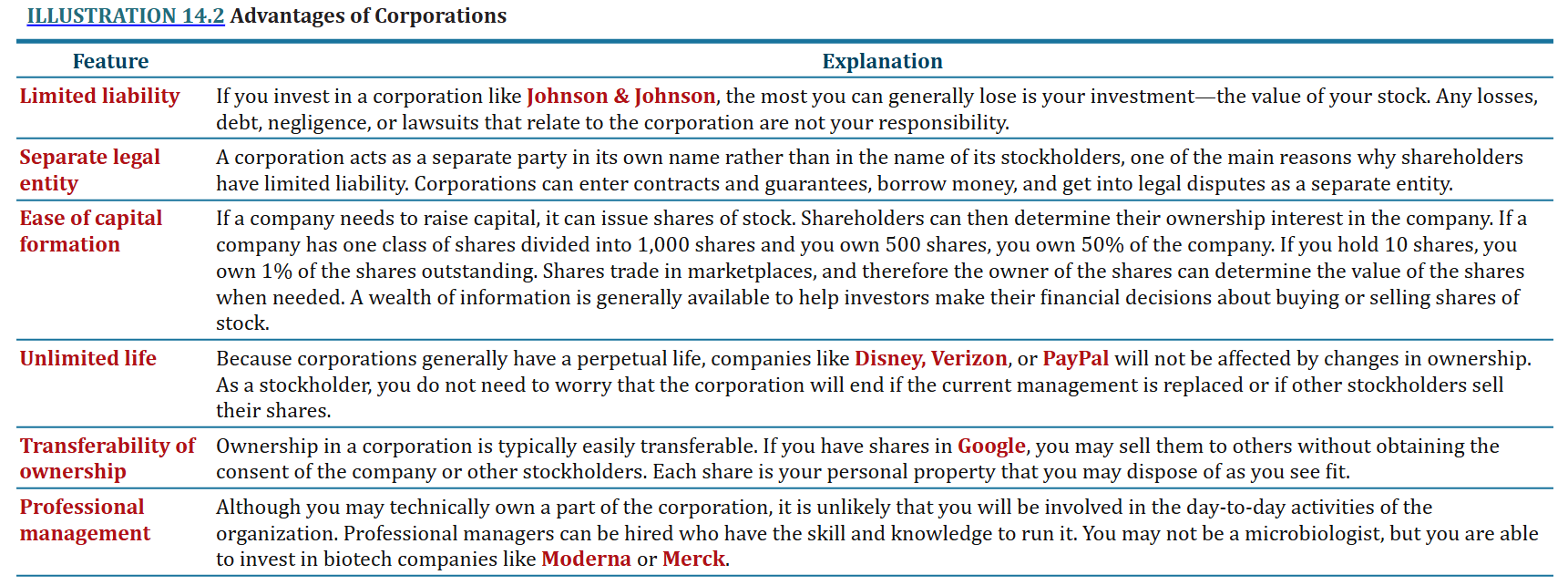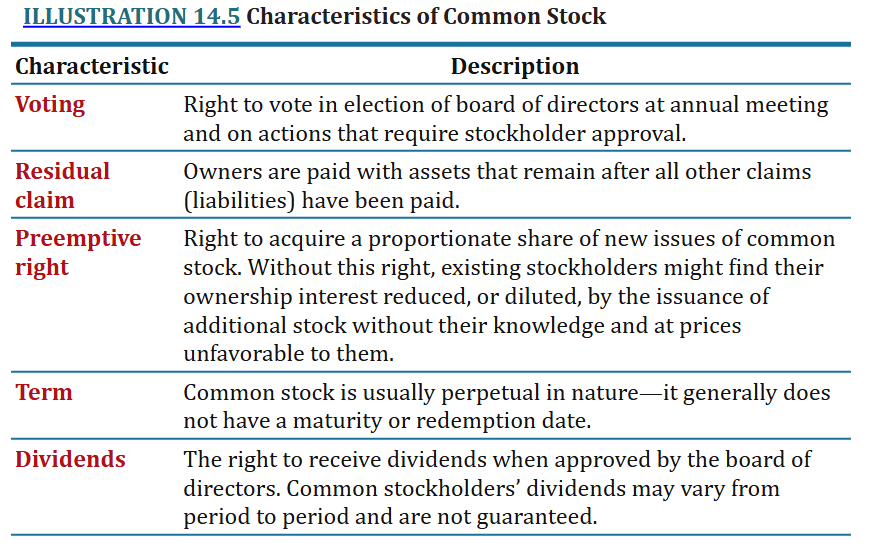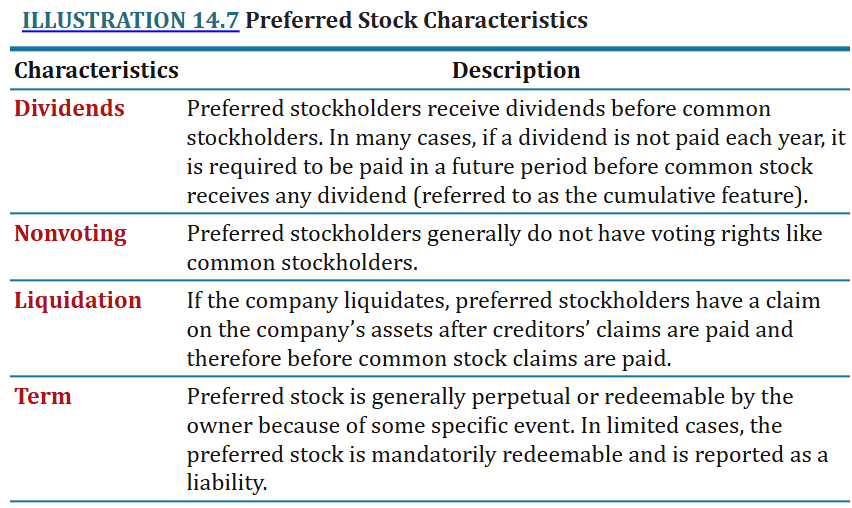Far 2 Chapter 14
1/34
There's no tags or description
Looks like no tags are added yet.
Name | Mastery | Learn | Test | Matching | Spaced |
|---|
No study sessions yet.
35 Terms
Differences between C Corp. and S Corp.
Taxation
C Corp faces double taxation
income tax on earnings
income tax on the dividends
S Corp pays no income tax
the taxable income from the corporation is taxed directly to the S corporation stockholders
Number of stockholders
C Corp has no restrictions
S Corp is limited to 100 stockholders
Advantages of Corporations
Limited liability
Separate legal entity
Ease of capital formation
Unlimited life
Transferability of ownership
Professional management

Disadvantages of Corporations
Taxation
Formation
Regulation
Separation from management

Articles of Incorpoation
A set of legal documents that contain general information about the business, such as name, location, address, names of directors, and areas of operation.
Corporate Charter
A document that describes the name and purpose of the corporation, the type and number of shares authorized, the names of the individuals who are forming the corporation, and the number of shares these individuals agree to purchase.
Stockholders’ (Owners’) Equity
Represents the cumulative net contributions by stockholders plus retained earnings and accumulated comprehensive income.
Capital Stock
Combination of common stock and preferred stock.
Contributed (Paid-in) Capital
The total amount paid in on capital stock—the amount provided by stockholders to the corporation for use in the business.
Earned Capital
Capital that develops from profitable operations. It consists of all undistributed income that remains invested in the company.
Retained Earnings
The earned capital of the company.
Accumulated Other Comprehensive Income
Reflects the aggregate amount of the other comprehensive income items. It includes such items as unrealized gains and losses on available-for-sale debt investments and unrealized gains and losses on certain derivative transactions.
Common Stock
The residual corporate interest that bears the risk of loss and receives the benefit of success. The key characteristics:
Voting
Residual claim
Preemptive right
Term Dividends

Paid-in Capital in Excess of Pay—Common Stock
Indicates any excess over par value paid in by stockholders in return for their shares issued to them.
No-Par Stock
Issuance of common stock without par value. Should be carried in the accounts at issue price.
Allowed to avoid confusion over the relationship, or lack of relationship between par value and fair value.
Major disadvantage is a high tax on these issues.
Stated Value
A requirement for no-par stocks by some states.
Creates the same issues as par value stock
accounts the same if it were par value stock
Proportional Method
If the fair value or other sound basis for determining relative value is available for each class of security, the company allocates the lump sum received among the classes of securities on a proportional basis.
Incremental Method
In instances where a company cannot determine the fair value of all classes of securities, it may use the incremental method. It uses the fair value of the securities as a basis for those classes that it knows, and allocates the remainder of the lump sum to the class for which it does not know the fair value.
Preferred Stock
A special class of shares that possess certain preferences, characteristics, or features no possessed by common stock.
Money is oftened used for special projects, like R&D or to fund an acquisition.

Cumulative Preferred Stock
If a corporation fails to pay a dividend in any year, it must make it up a later year before paying any dividends to common stockholders.
Participating Preferred Stock
Holders share ratably with the common stockholders in any profit distributions beyond the prescribed rate.
Convertible Preferred Stock
Allows stockholders, at their option, to exchange preferred shares for common stock at a predetermined ratio.
Callable Preferred Stock
Permits the corporation, at its option, to call or redeem the outstanding preferred shares are specified future dates and at stipulated prices.
Redeemable Preferred Stock
Allows the stockholder to redeem it at any time; the stockholder can “return” the stock to the company and be paid a set amount for the return of the stock.
Treasury Stock
Stock the company buybacks and plans to reissue.
contra-equity account
essentially the same as unissued capital stock
Cost Method
One of two general methods of handling treasury stock in the accounts.
A company will debit the Treasury Stock account for the reacquisition cost of the stock. On the balance sheet, this account is a deduction from the total paid-in capital and retained earnings.
Par (stated) Value Method
One of two general methods of handling treasury stock in the accounts.
All transactions in Treasury Stock are recorded at their par value. On the balance sheet, Treasury Stock is reported as a deduction from capital stock only.
Outstanding Stock
The number of shares of issued stock that stockholders own.
Types of dividends
Cash dividends
Property dividends or dividends in kind
Liquidating dividends
Property Dividends (dividends in kind)
Dividends payable in assets of the corporation other than cash.
may be:
merchandise
real estate
investments
Whatever form the board of directors designates
Liquidating Dividends
Dividends are a return of the stockholder’s investment rather than of profits; any dividend not based on earnings reduces corporate paid-in capital and to that extent.
Stock Dividend
The issuance by a corporation of its own stock to its stockholders on a pro rata basis, without receiving any consideration
par value of stock issued
fair value of the stock issued
Small (Ordinary) Stock Dividends
When a stock dividend is less than 20-25% of the common shares outstanding at the time of the dividend declaration, the company is therefore required to transfer the fair value of the stock issued from retained earnings.
Large Stock Dividend
A distribution of 25% or more of the common shares outstanding.
Difference between stock dividend and stock split
A stock dividend, although it increases the number of shares outstanding, does not decrease the par value; thus, it increases the total par value of outstanding shares.

Statement of Stockholders’ Equity basic format
balance at the beginning of the period
additions
deductions
balance at the end of the period